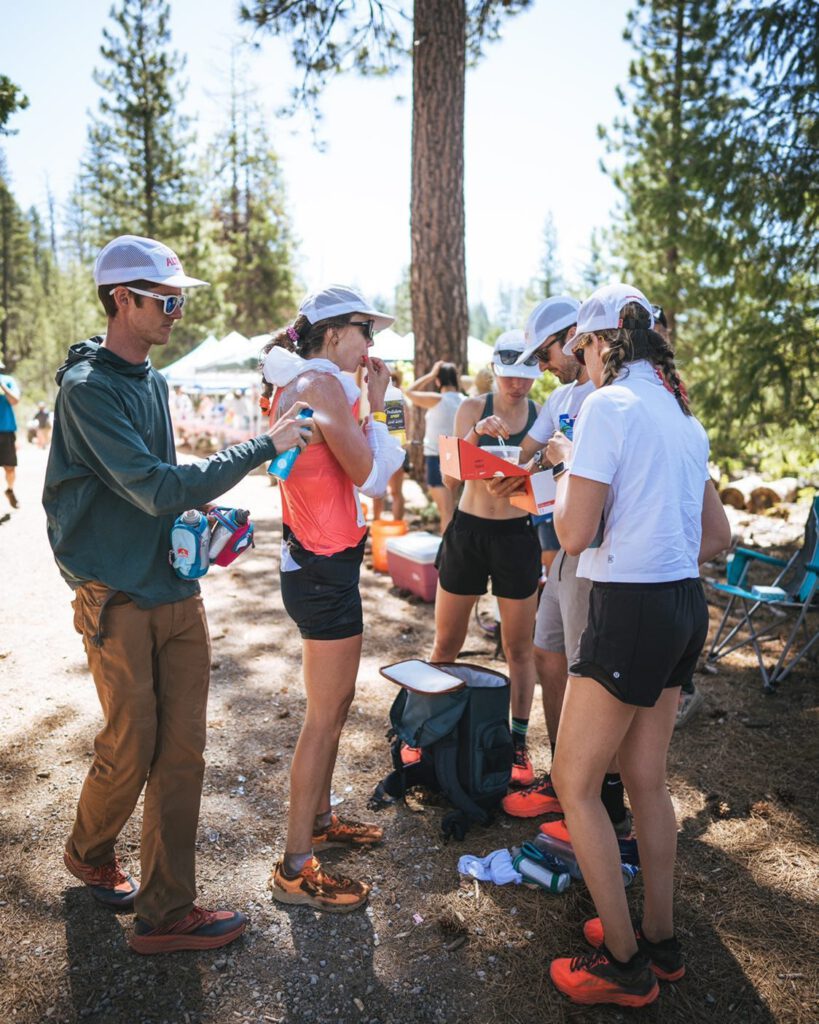The elusive DNF, did not finish, something we all do our best to avoid – sometimes even at all costs. However, due to the nature of our sport, at some point each of us will most likely find ourselves facing this decision. We will question our ability to go on and finish what we started. We will question our toughness, our perseverance, our ability to suffer. We will question our identity, our training, our bodies. Deciding to DNF a race teaches us a lot about ourselves. A DNF can highlight where we are the most mentally vulnerable, and where we are the strongest. They make us decide between being tough enough to continue, or tough enough to know when to stop.
To finish or not to finish, that is the question.
I first want to emphasize that I know that my circumstance is not relatable to all. I am fortunate to be running in the front of a race like Western States and I feel privileged to have another chance to get into Western States next year. Your reasons for a finish or a DNF may differ to mine. I really hope to help shed some light on the real feelings behind a DNF, normalize them, and lend some advice towards coping with the day.

Western States 2022
This past weekend I toed the line of the 49th inaugural Western States 100-mile Endurance Run, my favorite race in the world. I felt the most mentally and physically prepared for this race than any race I had ever started. I planned for all the controllable parts – I was holding myself accountable and planning to run a race true to myself and my potential. I planned out my nutrition, fueling, footwear, backup gear, F1 pit-stop crew and crew roles, cooling strategy, and back-up strategies for every piece of the puzzle. I was trying to account for everything that could go wrong. I was trying to control a sport, while forgetting that this sport, albeit incredible, comes with a lot of unpredictability. At its core it lacks an aspect of control. The unpredictability of ultra/trail running is what draws us to it, but it is also the part that may hurt us.
I started off the race running true to myself, never pushing, always checking in with my effort, and keeping calm. I was running with the top women from the beginning of the race, and I felt right at home. Around mile 12, I sprained my ankle badly in the high country, but after a couple of miles it calmed down. I pivoted to running the downhills a little more controlled and cautious to keep my quads fresh. This ended up being achievable, and as I ran down the first of 3 canyons, I was cautious, but still able to move downhill well. I climbed up Devil’s Thumb with the leaders and then continued to the second canyon. I was so excited for the second climb out, as it was my favorite, and I knew that I was climbing super easily and could hopefully stay close to the front of the race until we got to Foresthill. I was fueling well, hydrating and re-filling at all aid stations to make sure I didn’t run out of water during the hot, canyon miles. I continually filled my ice bandana and arm sleeves and sat in all the creeks. I had never felt this calm and in control in my entire running career. While I don’t want to say running 52 miles was easy, it sure felt that way in the moment. I was running exactly how I wanted to. It was my race.
Until it wasn’t my race.
It was an ultramarathon. An ultramarathon, that like all other ultramarathons, came with its own slew of unforeseen challenges. I sprained the same ankle for the second time about 1.5 miles from the bottom of Eldorado Canyon (canyon #2 out of 3) and at first, I thought it was going to be salvageable. But then every step brought a high sense of instability and a sharp pain up the medial (inside) part of my ankle and heel while trying to run. I was forced to slow way down and hobble the rest of the descent to the aid station. I was certain that it would fade, and I would be able to run uphill. However, it didn’t take me long to realize that this wasn’t going away. All I could do was walk. Walk with a smaller twinge of pain and a limp. I walked up the entire second canyon, a climb that I absolutely adore and typically split run/hike about 60/40. I got to the top but every time I tried to start running, I would immediately have to stop. I was gutted – knowing that I was not going to be able to finish. I had just been running so well, so intelligently, setting myself up to finish strong… and now here I was having to stop. Not finishing Western States was not something I had even thought was an option. I guess that was where I went wrong.
I got the ankle taped and attempted to run again, and realized it wasn’t in the cards. I wasn’t going to walk/limp the 45 miles to Auburn on a bum ankle and risk damaging it even more. I knew I didn’t need to unnecessarily suffer and harm my body more than usual. My crew was there for me as I talked through all these emotions and options and with their unwavering support we decided to stop. I will never forget those moments with my crew, they reminded me how lucky I was to have the support system I do, and for that I am eternally grateful.
I cried enough that day to fill up my tear bucket (is that a thing?) for the next year. Everyone who came up to me to ask about it triggered another uncontrollable flow of tears as I still couldn’t believe what had happened. It felt unfair, out of my control, unreal. But there was another side of me that felt that maybe I wasn’t tough enough, that my body failed me again. I questioned if I could have addressed the first sprain earlier, I could have tried harder, I could have walked it in. Within the same day I experienced the utmost joy and elation alongside the biggest heartbreak and sadness. I could simultaneously feel like it was totally out of my control and within my control at the same time. I was experiencing all these contradictory emotions all at once.
I keep reminding myself that I am allowed to feel these contradictory things. What we feel is uniquely ours and 100% real. We can experience the most joy paired with the most despair. We can both question our fitness and think we are the most prepared. We can feel like everything is within our control, yet out of our control. While this is just my personal story, I want to acknowledge that DNF’s can happen for a slew of other reasons aside from acute injury. But I think the real reason behind the DNF is not as important as how we view our own personal DNF, how we grieve the loss of a race that was and give ourselves the grace to move on. We give it our best on any given day, and choosing to DNF does not change that, it does not make us less of our former self, and it doesn’t change how our future races will go. In the grand scheme of the world, this is small potatoes, we must always remember that.
My best friend and crew-leader, Danielle Snyder, was the voice of reason in my ear during and immediately after this DNF and since has agreed to provide some advice for you all. She is a licensed mental health professional who works with a lot of incredible high-level athletes and is an extremely gifted athlete herself (previously holding the Oregon PCT FKT).
Danielle Snyder’s Rules for Dealing with a DNF are as follows:
- Allow yourself time and space to grieve. You trained hard and put a lot of time and energy into the event. It makes sense you are feeling sad.
- Give yourself a time limit on how long you let yourself sit in the sadness. Past a week or so, it’s going to start to integrate into a narrative about yourself and is not going to serve you.
- Normalize this experience. Taking a DNF is part of the sport. When we have big goals, sometimes they don’t pan out the way we want. That is the price we pay for believing in ourselves and trying something outside of our comfort zone. Once you move through the sadness, you can turn this into an opportunity for resiliency and growth.
- To help yourself channel DNF into growth consider what you can improve on next time and what is in your control. Take some time to recognize what you did well and what you learned from the race.
Danielle goes on to say:
DNFs are challenging because we care a lot. And it’s disappointing when we give our all and it doesn’t turn out the way we want. But we become stronger runners by working through missteps. Failure isn’t a bad thing, it’s an opportunity for growth. Ultra-running is a game of longevity and strong foundation. Every time we experience failure, we get another opportunity to rise up, to rise above.
Danielle Snyder
I have been putting Danielle’s practices to good use. I hope you can do the same.
I’ll leave you all with a simple reminder. This comes from a piece of advice I got from my partner, JT, and is as follows:
“Guess what, Jade (my dog) hasn’t heard about any of this, she has no clue what happened, and it doesn’t matter because she’s going to love you just the same.”
Perhaps we use this advice and insert our own name into it. Give ourselves the space to grieve, and then give ourselves the permission to forget and love ourselves just the same.
I’ll be counting down the days until I am back at Western States. Happy running all! ❤️
Danielle Snyder (IG: @diellesmells) and her sister currently accept coaching, nutrition, and mindset clients, you can find her services at Inner Drive Wellness.
